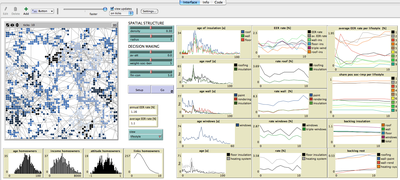Exploring homeowners' insulation activity 1.4.0
Insulating existing buildings offers great potential for reducing greenhouse gas emissions and meeting Germany’s climate protection targets. Previous research suggests that, since homeowners’ decision-making processes are inadequately understood as yet, today’s incentives aiming at increasing insulation activity lead to unsatisfactory results. We developed an agent-based model to foster the understanding of homeowners’ decision-making processes regarding insulation and to explore how situational factors, such as the structural condition of houses and social interaction, influence their insulation activity. Simulation experiments allow us furthermore to study the influence of socio-spatial structures such as residential segregation and population density on the diffusion of renovation behavior among homeowners. Based on the insights gained, we derive recommendations for designing innovative policy instruments. We conclude that the success of particular policy instruments aiming at increasing homeowners’ insulation activity in a specific region depends on the socio-spatial structure at hand, and that reducing financial constraints only has a relatively low potential for increasing Germany’s insulation rate. Policy instruments should also target the fact that specific renovation occasions are used to undertake additional insulation activities, e.g. by incentivizing lenders and craftsmen to advise homeowners to have insulation installed.

